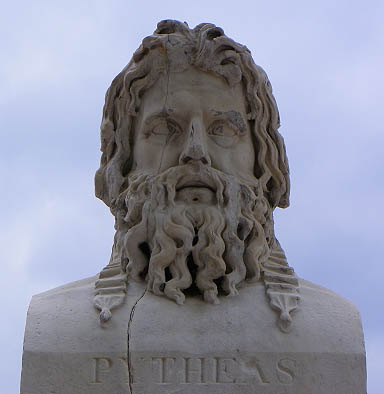
Pytheas of Massalia

Pytheas of Massalia (Ancient Greek: Πυθέας ὁ Μασσαλιώτης; Latin: Pitheas Massiliae; fl. 4th century BC), was a Greek geographer and explorer from the Greek colony of Massalia (modern-day Marseille). He made a voyage of exploration to northwestern Europe in about 325 BC, but his description of it, widely known in Antiquity, has not survived.
In this voyage he circumnavigated and visited a considerable part of Great Britain. He is the first person on record to describe the Midnight Sun. The theoretical existence of a Frigid Zone, and temperate zones where the nights are very short in summer and the sun does not set at the summer solstice, was already known. Similarly, reports of a country of perpetual snow and darkness (the country of the Hyperboreans) had reached the Mediterranean some centuries before. Pytheas is the first known scientific visitor and reporter of the Arctic, polar ice, and the Germanic tribes. He introduced the idea of distant Thule to the geographic imagination, and his account of the tides is the earliest known to suggest the moon as their cause. Pytheas may have reached Iceland and North America.
In Detail
In 1893, Sir Clement Markham, the noted British historian, published an article entitled "Pytheas, the Discoverer of Britain." The article attracted world-wide interest because, based on ancient writings, it claimed that a Greek navigator from the Greek colony of Massalia (today Marseilles) had circumnavigated Britain in the Fourth Century B.C., had "traveled all over it on foot" and had written a detailed account of his travels. Furthermore, Pytheas reported sailing northwest of the British Isles for six days until "an ocean of slush ice and fog so thick one could not sail through" forced him to turn back. During those six days, aided by the west-flowing off shore currents, could he have gone beyond Iceland to the shores of Greenland and the North Pole? During the reign of Alexander the Great?
Contrary to the stories told during the dark ages, the doctrine of a spherical earth was common knowledge among the educated Greeks of the time of Pytheas; and even earlier, among the Babylonians. Around 532 B.C., Pythagoras was one of the first to record that both the earth and its universe are spherical in shape. Later Aristotle, during the time of Pytheas, stated that the earth's mass is spherical in shape and pointed out: "... those mathematicians who try to compute the circumference of the Earth say that it is about 400,000 stadia."
Polybius, a Greek historian writing a century after Pytheas, noted that Pytheas, not a wealthy man, must have depended on the patronage of a wealthy Greek merchant to acquire, outfit and provision his ship. That merchant was undoubtedly interested in tin ("kassiteros" in Greek) which, when blended with copper, produced the highly prized and valuable bronze: the metal of choice in those years. Used to make all types of tools, coins and ornaments, it was especially prized for the production of effective weapons that were highly prized by foot soldiers and their leaders.
For centuries, the Kassiterides Islands (British Isles) were well known to the Phoenicians as a principal source of tin. Herodotus, the ancient Greek historian (484-425BC) had reported that their boats sailed through the Pillars of Hercules (Straits of Gibraltar), then north along the coast of Gaut to an area now known as Cornwall, England. Pytheas decided to find these islands on his own, to locate the fabled sources of tin and to search for new deposits. While, ostensibly, his purpose was to bring back a load of tin for profit, Pytheas had the heart and mind of a true explorer. He was curious, he, wanted to see and visit the islands of which he had heard rumors, to explore what lay beyond and to return and tell the world of his findings.
As history will be served, two additional attributes played an immense role. First and foremost, because of his training as a mathematician and astronomer, Pytheas had acquired the important discipline of observing and recording his findings. Second, as a ships navigator, he had mastered the use of the "Gnomon," an instrument similar to the hexante (sextant) used by Greek and Phoenician sailors since the sixth century B.C.
With it, the ancient navigators were able to navigate away from the sight of land and to perform the astounding calculations about which we marvel today. In fact, Pytheas was the first person we know by name to have used it to calculate the latitude of Massalia, which he found to be 43' 1 I' North, almost matching the true figure of 43' 18'North for modern day Marseilles. The ability to record the precise location of different sites along his travels proved invaluable to him, helped him to establish the accuracy of his log, and provided the proof needed for modern day historians to confirm his writings.
In order to avoid the Phoenicians, Pytheas reported sailing, slowly and carefully, for five full days from Massalia to the Pillars of Hercules before turning north to the Kassiterides Isles. He stopped at many points along the way to explore the area and to refresh the boat's water and provisions. He often traveled inland with his crew, recorded geographical features and reported the customs and habits of the inhabitants in such detail that it led Sir Clement Markham to declare that Pytheas was, indeed, the discoverer of Great Britain.
All types of events and strange stories were reported by Pytheas. One such "incredible" story, which he reported, told him by the inhabitants of northern Scotland, was about the presence of a place to the north where there were only two or three hours of night during parts of the year, and another place even further north where the sun shone all night long. Another, was the practice of people living in log and clay houses, storing their grain underground because of the cold, and thrashing their grain in barns or covered structures rather than on the open fields as was common in the warmer lands bordering the Mediterranean. Common knowledge today, these stories were considered fantasy in those years.
Traveling north from Scotland, Pytheas encountered a cluster of small islands where he reported seeing large, boat-size fish, lazily swimming on the surface and loudly blowing out sprays of water. Incredibly as this may have been to Pytheas and his crew, who had probably never seen a whale before, such pods of whales are common to those waters. He reported sailing six days northwest towards what he calls Thule or Hyperborea (probably Iceland or Greenland or... - The Greeks tell of a people called the Hyperboreans who live "beyond the north wind". Boreas was god of the north wind, and the Hyperboreans lived beyond his rule. They are a happy people who do not suffer from usual afflictions. Pindar writes of them: "With shining laurel wreaths about their locks (of hair), they hold feasts out of sheer joy. Illnesses cannot touch them, nor is death foreordained for this exalted race." - ...where he encountered dense fog described as so thick and eerily quiet that the ship and the sea seemed suspended in a void. He recorded the presence of water and slush ice that "binds all together, and can be traveled neither on foot nor by boat". This condition would not permit him to go further and forced him to turn back.
It is significant to remember that the Gulf Stream brings a tremendous current of warm water from the Caribbean across the Atlantic Ocean in a northeasterly direction until it meets the colder air and flow of the Arctic Sea, at which point it starts its circle back to the west. It seems clear that the relatively short distance northwest from Scotland to Iceland, compared to the much longer distance from Massalia to the Straits of Gibraltar, prompts one to speculate as to the distance Pytheas could have sailed beyond Iceland. The five days of slow, cautious sailing from his home port of Massalia to the southern tip of Spain, covering a distance of about 600 nautical miles, when compared to his longer sail of six days, northwest, towards Iceland (approximately 500 nautical miles) at a rate of approximately 240 nautical miles per day, would have placed him far beyond Iceland. When one factors in the push he would have received from the west flowing currents of the Gulf Stream and the additional benefit of not having to worry about the Phoenicians, we can reasonably surmise that he was close to the shores of Greenland before the fog and slush ice turned him back. On a clear day he would have been able to see the mountains of Greenland, to wonder about its inhabitants, and, perhaps, to speculate on the presence of tin.
Not until the beginning of the 20th century and to Arctic explorers like Fridtjof Nansen and Vilhjalmur Stefansson were we able to explain and confirm his descriptions of the many strange and fascinating accounts he had experienced including the strange mixture of fog, air, ice and water in those wild, windy and frigid seas.
How devastated he must have been when he returned to Massalia to report these wondrous findings only to be greeted with disbelief and scorn. The writers and historians were content in their dated knowledge that since the ocean ceases being liquid at such far northern latitudes, there is no way anyone can sail north of Scotland, unless he had an ice boat. Yet, we know today that he was describing the conditions of that region and the inhabitants of those lands.
Most people argue that it was the Norseman, Lief Ericson, or the Genoese, Christopher Columbus, who should be given credit for first probing the shores of the "new world." But perhaps it was a much earlier explorer-many, many centuries earlier-named Pytheas who deserves the honor. We do not know. But we do know, categorically, that Pytheas, the intrepid Greek sailor and navigator from Massalia, deserves to join the ranks of Columbus, Ericson and the other great explorers of history. As for many of us, we are convinced that Pytheas traveled to the edge of the "new world" during the time of Alexander the Great!
Sources:
John B. Farmakides: Pytheas the explorer (330 B.C.). The Ahepan, 2000.
Barry Cunliffe: The extraordinary voyage of Pytheas the Greek. Walker & Co., 2002
The Northern Lights Route - The Council of Europe Cultural Routes: The voyage of Pytheas to Thule. University Library of Tromsø, 1999.
Felix and Anthea Baker: The first explorers. London: Aldus Books, 1971.
Ian Cameron: Pytheas. In: Into the Unknown. The Story of Exploration. Washington: National Geographic Society, 1987.
R. Chevalier: The Greco-Roman Conception of the North: from Pytheas to Tacitus, 1984.
[1]
Sources
Our Mobile Application
Check out Our Mobile Application "Ancient Greece Reloaded"


